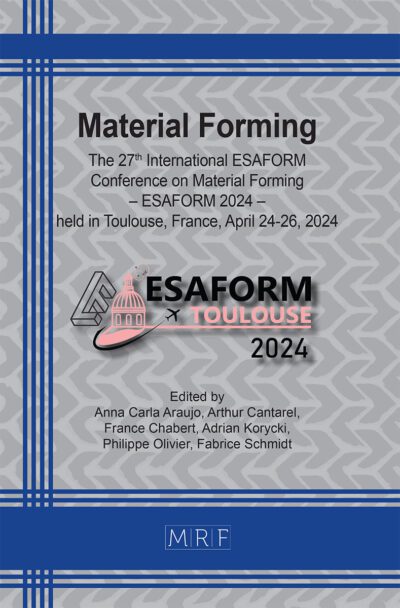Investigation of the influence of tool geometry on sheet thinning of bipolar plates in multi-stage embossing
Max MEERKAMP, Lars UHLMANN, Jan SOMMER, Martina MÜLLER, Tim HERRIG, Thomas BERGS
Abstract. The mobility sector is a major contributor to greenhouse gas emissions in the European Union (EU). One approach to reduce these emissions and meet EU climate targets is the use of alternative propulsion concepts, such as hydrogen fuel cells (FC). The economic efficiency of the FC is closely tied to their performance, which depends on multiple criteria, such as the reactant distribution and water management. A key component of the FC is the bipolar plate (BPP), as its channel structure directly impacts these criteria. Today, a BPP is typically formed using multi-stage embossing. However, in multi-stage embossing, the optimization of the channel structure regarding the performance of the FC is limited by the plastic deformation capacity of the material used for the BPP. During embossing the material experiences plastic deformation, resulting in sheet thinning. Once a critical thinning is reached, the channel structure tears. One way to reduce sheet thinning is by controlling the material flow during embossing. In multi-stage embossing, the material flow can be controlled by adjusting the tool geometry of each embossing step. Therefore, this paper investigates the influence of the tool geometry of the individual embossing steps on material flow and its effect on the resulting sheet thinning of BPP in multi-stage embossing.
Keywords
Bipolar Plate, Embossing, Metal Foil, Multi-Stage Forming, Sheet Thinning
Published online 5/7/2025, 10 pages
Copyright © 2025 by the author(s)
Published under license by Materials Research Forum LLC., Millersville PA, USA
Citation: Max MEERKAMP, Lars UHLMANN, Jan SOMMER, Martina MÜLLER, Tim HERRIG, Thomas BERGS, Investigation of the influence of tool geometry on sheet thinning of bipolar plates in multi-stage embossing, Materials Research Proceedings, Vol. 54, pp 1257-1266, 2025
DOI: https://doi.org/10.21741/9781644903599-137
The article was published as article 137 of the book Material Forming
![]() Content from this work may be used under the terms of the Creative Commons Attribution 3.0 license. Any further distribution of this work must maintain attribution to the author(s) and the title of the work, journal citation and DOI.
Content from this work may be used under the terms of the Creative Commons Attribution 3.0 license. Any further distribution of this work must maintain attribution to the author(s) and the title of the work, journal citation and DOI.
References
[1] Information on https://www.destatis.de/Europa/DE/Thema/GreenDeal/GreenDeal.html
[2] A. Cornet, H. Deubener, R. Dhawan, T. Möller, A. Padhi, P. Schaufuss, T. Tschiesner, Race 2050 – A Vision for the European Automotive Industry, McKinsey & Company (2019). Information on https://www.mckinsey.de/publikationen/2019-01-08-race-2050-publikation
[3] Information on https://climate.ec.europa.eu/eu-action/transport/reducing-emissions-aviation
[4] R. Whalen, T. Eisenhart, A. Gordon, M. Deimler, P. Losada, C. Follette, Plotting Aviation’s Uncharted Course to Net Zero, Boston Consulting Group (2021). Information on https://www.bcg.com/publications/2021/net-zero-aviation-is-the-future-of-aviation
[5] A. Cornet, R. Heuss, A. Tschiesner, R. Hensley, P. Hertzke, T. Möller, P. Schaufuss, J. Conzade, S. Schenk, K. von Laufenberg, Why the automotive future is electric, McKinsey & Company (2021). Information on https://www.mckinsey.com/industries/automotive-and-assembly/our-insights/why-the-automotive-future-is-electric
[6] A. Bauer, Experimentelle und numerische Untersuchungen zur Analyse der umformtechnischen Herstellung metallischer Bipolarplatten, Dissertation TU Chemnitz (2020). https://nbn-resolving.org/urn:nbn:de:bsz:ch1-qucosa2-715389
[7] S. Porstmann, T. Wannemacher, W.-G. Drossel, A comprehensive comparison of state-of-the-art manufacturing methods for fuel cell bipolar plates including anticipated future industry trends, Journal of Manufacturing Processes 60 (2020) 366–383. https://doi.org/10.1016/j.jmapro.2020.10.041
[8] M. Fiedler, K. Kittner, B. Awiszus, Production of Metallic Bipolar Plates Made of Stainless Steel by Incremental Hollow Embossing Using Rollers, Eng. Proc. 26(1) (2022) 1-9. https://doi.org/10.3390/engproc2022026015
[9] J.B. Bong, L. Lee, J.-H. Kim, F. Barlat, M.-G. Lee: Two-stage forming approach for manufacturing ferritic stainless steel bipolar plates in PEM fuel cell: Experiments and numerical simulations. International Journal of Hydrogen Energy 42 (2017) 6965-6977.
https://doi.org/10.1016/j.ijhydene.2016.12.094
[10] J. Sommer, M. Müller, T. Herrig, T. Bergs, Simulative and empirical investigation of test specimen geometries for the determination of forming limit states in the tensile-compression range for austenitic stainless steel foil material, Proceedings of the 14th International Conference on the Technology of Plasticity – Current Trends in the Technology of Plasticity (2203) 254-265.
https://doi.org/10.1007/978-3-031-42093-1_25
[11] F. Klocke, D. Trauth, A. Shirobokov, P. Mattfeld, FE-analysis and in situ visualization of pressure-, slip-rate-, and temperature-dependent coefficients of friction for advanced sheet metal forming: development of a novel coupled user subroutine for shell and continuum discretization, Int J Adv Manuf Technol 81, (2015) 397–410. https://doi.org/10.1007/s00170-015-7184-1












